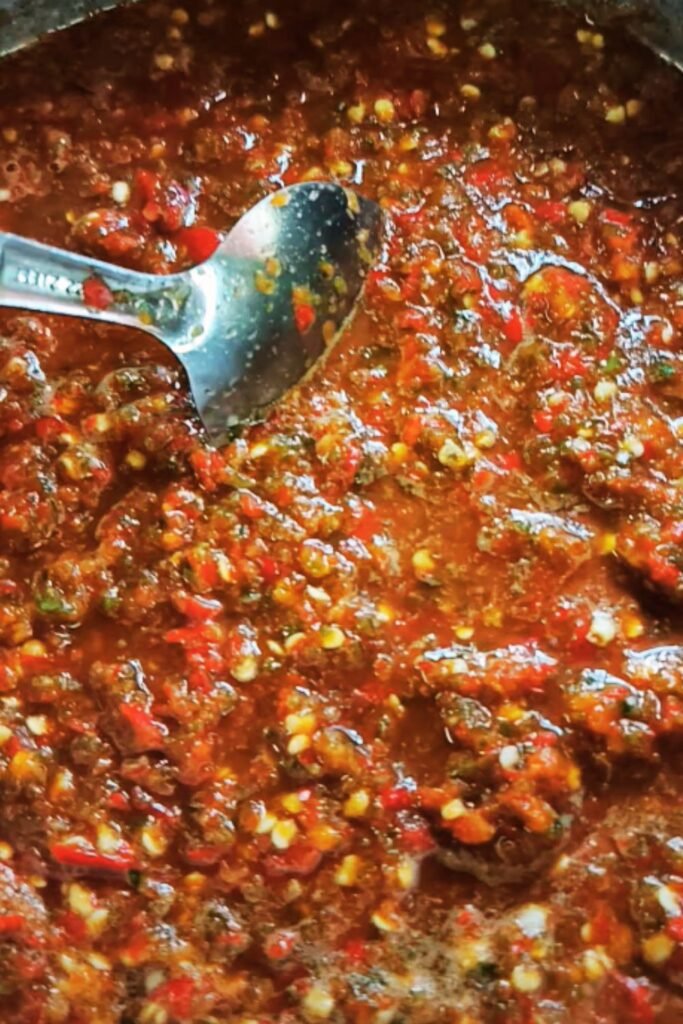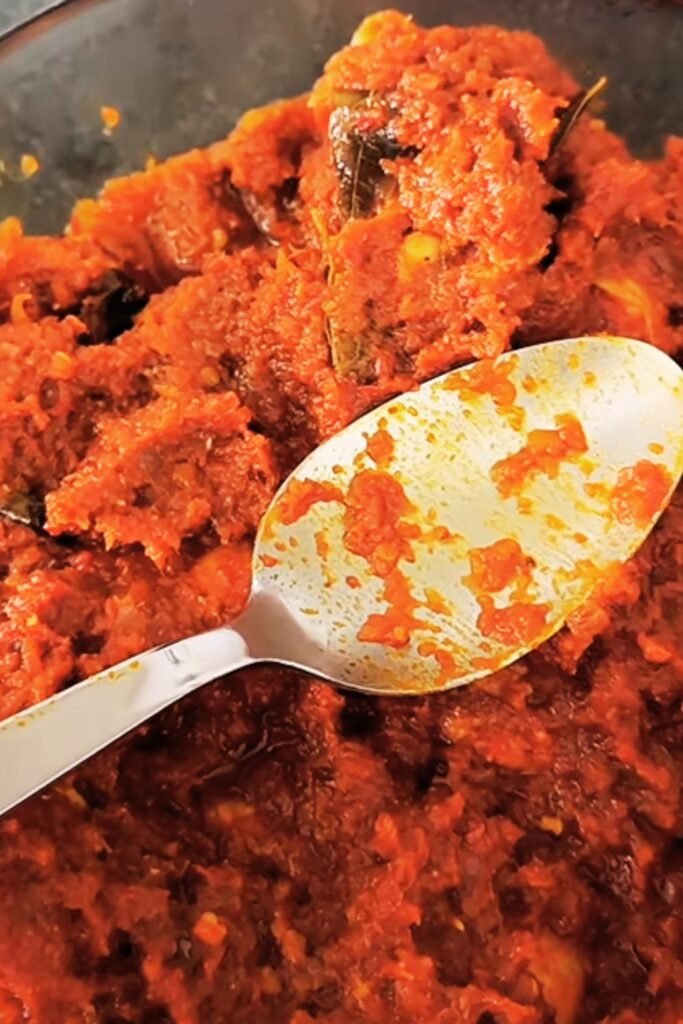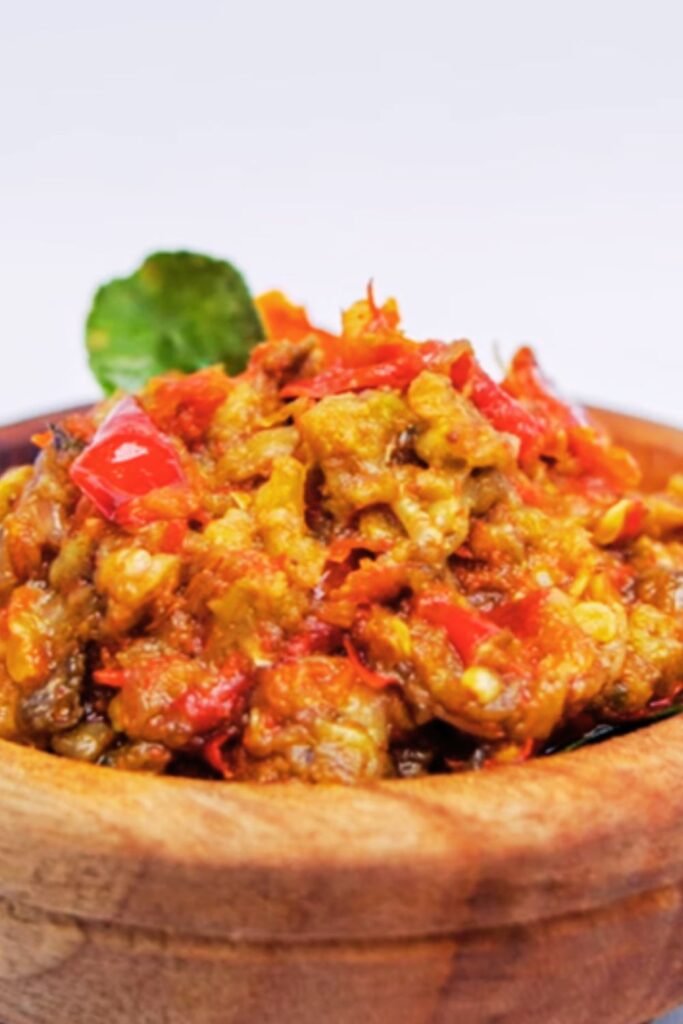Have you ever tasted something so intensely flavorful that it completely transforms a simple meal into an extraordinary experience? That’s exactly what sambal belacan does, and I’m thrilled to share my perfected recipe with you today. This fiery, pungent condiment from Southeast Asia has become my kitchen secret weapon, and after reading this guide, it might just become yours too.
What is Sambal Belacan?
Sambal belacan is a spicy chili paste that originates from Malaysia, Indonesia, and Singapore. It combines the heat of fresh chilies with the unique umami punch of belacan (fermented shrimp paste). While there are countless variations of sambal throughout Southeast Asia, this belacan version offers a distinct depth that elevates any dish it touches.
I still remember my first encounter with sambal belacan during a trip to Penang. One spoonful alongside a simple plate of rice and vegetables, and I was immediately hooked. The complex flavors—spicy, savory, tangy, and slightly funky—created a perfect harmony that I knew I had to recreate at home.
The Magic of Belacan
Before we dive into the recipe, let’s talk about what makes belacan so special. Belacan is a fermented shrimp paste that’s been used in Southeast Asian cooking for centuries. It’s made by:
- Fermenting tiny shrimp or krill with salt
- Drying the mixture under the sun
- Compressing it into solid blocks
- Further fermenting until it develops its characteristic aroma
Raw belacan has an incredibly potent smell that might initially seem off-putting to newcomers. But don’t let that scare you away! Once toasted and incorporated into sambal, it transforms into an umami-rich flavor enhancer that gives the condiment its distinctive character.

Essential Ingredients for Authentic Sambal Belacan
The beauty of sambal belacan lies in its simplicity. With just a handful of fresh ingredients, you can create something truly magical:
| Ingredient | Quantity | Notes |
|---|---|---|
| Fresh red chilies | 200g (about 20-25) | Thai bird’s eye or finger chilies work best, adjust quantity for heat preference |
| Belacan (shrimp paste) | 2 tablespoons | Always toast before using |
| Shallots | 5-6 medium | Provides subtle sweetness |
| Garlic | 4-5 cloves | For depth and aroma |
| Lime juice | 3-4 tablespoons | Fresh is essential, adds brightness |
| Palm sugar | 1-2 teaspoons | Creates balance with heat |
| Salt | To taste | Sea salt preferred |
| Cooking oil | 3-4 tablespoons | For frying |
| Kaffir lime leaves (optional) | 2-3 leaves | Infuses aromatic citrus notes |
| Torch ginger flower (optional) | 1 small bud | Authentic fragrant addition if available |
Equipment You’ll Need
Getting the perfect texture for sambal belacan requires some specific tools:
- Mortar and pestle – Traditional and preferred for authentic texture
- Food processor – For quick preparation (though texture differs slightly)
- Heavy-bottomed pan – For toasting belacan and cooking sambal
- Heat-resistant spatula – For stirring during cooking
Step-by-Step: Making Perfect Sambal Belacan
1. Prepare Your Belacan
The first step is crucial: toasting the belacan to eliminate its raw smell and enhance its flavor.
- Cut a 2-tablespoon portion from your belacan block
- Wrap it tightly in aluminum foil
- Toast it in a dry pan over medium heat for 4-5 minutes, flipping occasionally
- Allow it to cool before unwrapping (the smell will be less intense after toasting)
Pro Tip: If you’re sensitive to strong smells, toast your belacan outdoors or ensure good kitchen ventilation. The aroma is powerful but will dissipate quickly.
2. Prep Your Chilies
The choice of chilies dramatically impacts your sambal’s heat level and flavor profile:
- Remove stems from chilies
- For a milder sambal, remove seeds from half or all of the chilies
- Roughly chop chilies for easier processing
I personally leave most of the seeds intact because I enjoy the heat, but you can adjust based on your preference. A mix of different chilies also creates more complex flavors – I sometimes combine bird’s eye chilies with larger red chilies for balanced heat and color.
3. Prepare Aromatics
- Peel shallots and garlic
- Roughly chop them to make grinding easier
- If using kaffir lime leaves, remove the tough center stem and finely slice
4. The Traditional Method (Mortar and Pestle)
There’s something deeply satisfying about making sambal belacan the traditional way:
- Add a pinch of salt to your mortar (this helps with grinding)
- Start with garlic and pound until crushed
- Add shallots and continue pounding
- Incorporate chilies gradually, pounding after each addition
- Add the toasted belacan and continue pounding
- The resulting paste should be coarse yet well-combined
Working with a mortar and pestle develops your arm muscles while creating a texture that’s impossible to achieve with electrical appliances. The crushing action releases oils and flavors in a way that chopping simply can’t match.
5. The Quick Method (Food Processor)
When I’m short on time but craving sambal:
- Add chilies, shallots, and garlic to the food processor
- Pulse until coarsely chopped
- Add toasted belacan
- Process until desired consistency is reached (avoid over-processing)
While this method is faster, be careful not to turn it into a completely smooth paste. Sambal belacan should retain some texture.
6. Cooking Your Sambal
Now for the transformation:
- Heat oil in a heavy-bottomed pan over medium heat
- Add the chili paste mixture
- Cook, stirring frequently, for 10-15 minutes until the oil separates
- Add palm sugar and continue cooking until dissolved
- Remove from heat and stir in fresh lime juice
- Season with salt to taste

The cooking process mellows the raw flavors while intensifying the overall profile. You’ll notice the color deepen and the aroma become more complex as it cooks. When the oil begins to separate and rise to the surface, that’s your signal that the sambal is nearly ready.
Secret Tips for Extraordinary Sambal Belacan
After years of tweaking my recipe, I’ve discovered several tricks that elevate homemade sambal belacan from good to exceptional:
1. The “Twice-Cooked” Method
For exceptional depth of flavor, try this:
- Cook the sambal as directed above
- Allow it to cool completely
- Return it to the pan and cook again for another 5-7 minutes
- Add a splash more oil if needed
This extra step caramelizes the sugars further and develops richer flavors. I discovered this accidentally when reheating leftover sambal and noticed the improved taste.
2. Balancing Acidity
The lime juice isn’t just for flavor – it’s crucial for balance:
- Add half the lime juice during cooking
- Stir in the remaining juice after removing from heat
- This preserves the fresh citrus aroma while still allowing some to cook into the mixture
3. The Oil Separation Test
Professional sambal makers judge doneness by oil separation:
- When tiny pools of oil form on the surface of your cooking sambal, it’s reaching doneness
- This indicates the water content has reduced sufficiently
- Proper oil separation also extends shelf life
4. Controlling Heat Levels
Create your perfect heat level by:
- Using different chili varieties (long red chilies are milder, bird’s eye are hotter)
- Keeping or removing seeds based on preference
- Adding a small amount of rehydrated dried chilies for deeper flavor without excessive heat
5. Texture Matters
The ideal texture is coarse enough to provide bite but fine enough to spread easily:
- If using a food processor, pulse rather than continuous processing
- When using mortar and pestle, aim for consistency similar to coarse sand
- Never process to a completely smooth paste
Storage and Shelf Life
Properly made sambal belacan can last surprisingly long:
| Storage Method | Expected Shelf Life | Notes |
|---|---|---|
| Room temperature | 1-2 days | In tropical climates, not recommended |
| Refrigerated (airtight container) | 2-3 weeks | Best for regular use |
| Refrigerated (oil-topped) | 3-4 weeks | Add a thin layer of oil on top |
| Frozen in ice cube trays | 3-6 months | Portion-sized convenience |
| Vacuum sealed | 4-6 months | Best for long-term storage |
I’ve found that storing sambal belacan in small, sterilized glass jars with a thin layer of oil on top works wonderfully. The oil creates a barrier against air, extending freshness. Just be sure to always use a clean spoon when taking portions to prevent contamination.

Ways to Use Sambal Belacan
This versatile condiment transforms countless dishes:
As a Condiment
- Served alongside rice dishes
- Added to noodle soups
- Paired with grilled meats or seafood
As an Ingredient
- Stir-fried with vegetables (sambal kangkung is a classic)
- Mixed into marinades for meat or seafood
- Incorporated into fried rice for heat and depth
- Stirred into soups and stews
Creative Applications
- Spread thinly on sandwiches or burgers
- Tossed with roasted vegetables
- Mixed with mayonnaise for a spicy spread
- Added to scrambled eggs for breakfast with a kick
Regional Variations
While my recipe reflects the Malaysian-style sambal belacan I fell in love with, there are fascinating regional differences:
| Region | Variation | Key Differences |
|---|---|---|
| Malaysia | Traditional Sambal Belacan | Balanced heat, prominent belacan flavor |
| Indonesia (Java) | Sambal Terasi | Often includes tomatoes, sometimes sweeter |
| Singapore | Nonya Sambal Belacan | More lime juice, sometimes includes belachan kaffir lime leaves |
| Southern Thailand | Nam Prik Kapi | Includes fish sauce, often served with vegetables |
| Penang | Penang-style Sambal | Includes tamarind for sourness rather than lime |
Each variation reflects local tastes and available ingredients. If you enjoy exploring different flavor profiles, try adapting the recipe to include regional touches like tamarind paste or additional herbs.
Troubleshooting Common Issues
Even experienced cooks sometimes encounter challenges when making sambal belacan:
Too Watery
- Solution: Continue cooking longer to evaporate excess moisture
- Prevention: Use mature chilies with less water content
Too Pungent
- Solution: Add more palm sugar and lime juice to balance
- Prevention: Toast belacan thoroughly before adding
Burns Easily
- Solution: Lower heat and add a splash more oil
- Prevention: Use a heavy-bottomed pan and stir constantly
Ferments Too Quickly
- Solution: Store with a layer of oil on top
- Prevention: Make sure all utensils are clean when handling
Health Benefits
Beyond its incredible flavor, sambal belacan offers several health benefits:
- Capsaicin from chilies may boost metabolism
- Antioxidants from fresh ingredients fight inflammation
- Probiotics from fermented belacan support gut health
- Low in calories when used as a condiment (about 15-20 calories per teaspoon)
Of course, moderation is key due to the sodium content from belacan and added salt.
Serving Suggestions
Sambal belacan transforms simple dishes into memorable meals:
Perfect Pairings
- Plain steamed rice with fried egg and cucumber slices
- Grilled fish with lime wedges
- Stir-fried water spinach (kangkung)
- Coconut rice (nasi lemak)
- Fried chicken
- Steamed okra or eggplant
Complete Meal Ideas
- Breakfast: Coconut rice, sambal belacan, cucumber slices, and a fried egg
- Lunch: Steamed rice, sambal belacan, grilled fish, and stir-fried vegetables
- Dinner: Rice noodles with sambal belacan, prawns, and fresh herbs
Non-Alcoholic Drinks That Complement
- Cold coconut water
- Iced lemongrass tea
- Sweetened soy milk
- Fresh lime juice with soda water
Q&A Section
Q: Can I substitute belacan with something else if I can’t find it? While nothing perfectly replicates belacan’s unique flavor, in a pinch you can substitute with Thai shrimp paste (kapi) or Filipino bagoong. For vegetarians, try fermented soybean paste (miso) mixed with a small amount of mushroom powder for umami, though the flavor profile will differ significantly.
Q: How can I reduce the spiciness without compromising flavor? Remove all seeds and membranes from the chilies before processing. You can also substitute some of the hot chilies with larger, milder varieties like red bell peppers. Adding more palm sugar and lime juice helps balance the heat as well.
Q: My sambal turns black after a few days in the refrigerator. Is it still safe to eat? Slight darkening is normal due to oxidation and doesn’t affect safety or flavor. However, if you notice any off smells, fuzzy growth, or bubbling, these are signs of spoilage and the sambal should be discarded.
Q: Can I make sambal belacan without cooking it? Traditional sambal belacan is always cooked to develop flavor and extend shelf life. Raw versions exist but have a much shorter shelf life (1-2 days refrigerated) and a sharper, more pungent taste that some find overwhelming.
Q: Is there a way to make sambal belacan less pungent for those new to belacan? Start with a smaller amount of belacan (perhaps 1 teaspoon instead of 2 tablespoons) and increase in future batches as you develop a taste for it. Thorough toasting also mellows the pungency considerably.
Q: Can I freeze sambal belacan? Absolutely! Freezing in ice cube trays creates convenient portions that thaw quickly. Once frozen, transfer the cubes to a freezer bag. Use within 6 months for best quality.
Final Thoughts
Making your own sambal belacan connects you to centuries of culinary tradition while creating something truly spectacular for your table. Yes, it requires some special ingredients and a bit of effort, but the rewards are immeasurable—a condiment so versatile and flavorful that it will completely transform your home cooking.
I still remember watching my friend’s Malaysian grandmother making sambal belacan, carefully adjusting flavors and nodding with satisfaction as the aroma filled her kitchen. That memory inspires me every time I make this recipe, reminding me that some foods are worth the extra effort.
Give this recipe a try, and I’m confident it will become a staple in your kitchen too. Whether used as a simple condiment or as a flavor base for complex dishes, homemade sambal belacan is truly a culinary treasure that deserves a place in every adventurous cook’s repertoire.
Happy cooking, and don’t forget to embrace the heat!